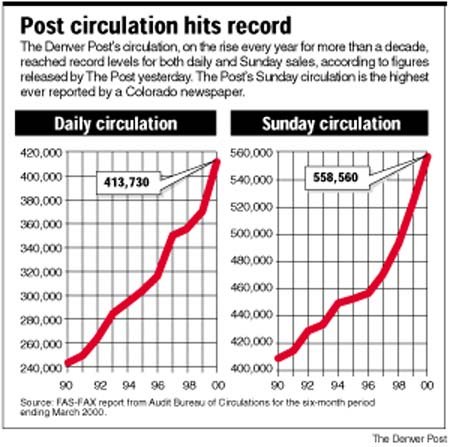A report from the newspaper industry’s Audit Bureau of Circulations showed The Post’s Sunday growth at 35,236 newspapers, or 6.7 percent. It was the 11th straight year of Sunday circulation growth for The Post, and the sixth straight year it has led on Sunday against its principal rival, the Denver Rocky Mountain News.
Daily circulation at The Post rose 11.7 percent, adding 43,307 to reach 413,730. Post officials said it was the largest year-over-year daily increase in the newspaper’s history and the 15th straight year of daily circulation growth.
“In the last year, we’ve again increased the space we provide for news and added columnists, new features and sections, and readers and advertisers have responded positively as this record circulation indicates,” said Post Publisher Gerald Grilly.
The Post’s recent journalistic accomplishments include winning its fifth Pulitzer Prize, for breaking-news coverage of the Columbine High School shootings. The News also won a Pulitzer, for photography on the Columbine story.
Grilly cited such new Sunday features in The Post as Access magazine for computer users and the Sunday Wall Street Journal’s personal finance section. The Post also has created new Denver neighborhood beats, re-established the Rocky Mountain Ranger roving reporter and strengthened its bureau in Washington, D.C.
“We’re committed to continuing our role as the news and market leader in Colorado,” Grilly added.
The News, which announced preliminary circulation results more than two weeks ago, recorded increases in both daily and Sunday circulation for the recent sixmonth period.
Numbers released Monday by the Audit Bureau showed the News gaining 90,981 on Sunday, for a total circulation of 552,085, slightly behind The Post’s Sunday circulation. The News’ Sunday gain was 19.7 percent. The newspaper’s daily circulation for the recent period was 446,465, a gain of 24.3 percent from the year-earlier period, said Linda Sease, the News’ vice president of marketing and new media.
The News has been particularly aggressive in offering special deals to entice new readers, including a current promotion that delivers the News to subscribers six days a week for $4.95 a year.
Sease said there is a new “savvy consumer” – influenced by the Internet – who expects to get information “for free or next to free.” She said research at the News shows “discount subscribers” are an audience newspapers have been losing – young, educated readers who have “a lot of media choices.” They will subscribe to newspapers, “but on their terms and conditions,” Sease added.
In response, Grilly cited a recent report by DLJ Media Research, a leading national analyst of publicly held media companies, about the aggressive discounting strategy in Denver by the News’ parent company, E.W. Scripps Co.
“The company continues to pursue what appears to DLJ to be a kamikaze strategy with the newspaper,” said the DLJ report report.
Said Grilly: “The strategy is producing record financial losses for their newspaper, and they expect their advertisers to pay for them. This is more of their 2-year-old penny subscription strategy that is of little or no value to an advertiser. The advertisers in this marketplace are extremely savvy, very smart and will continue to analyze their advertising based on real readers and real results.”
Circulation gains by both Denver dailies buck a trend that has seen circulation flat or declining at some papers across the nation.
“Denver proves that it’s not a given that newspaper circulation has to decline forever, but the logical corollary is at what cost?” said Peter Appert, a media industry analyst with the investment brokerage Deutsche Banc Alex Brown. “Perhaps there is a happy medium where circulation can be enhanced without massive giveaways.”











